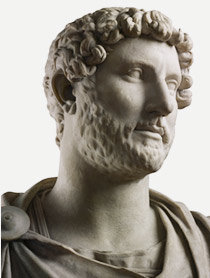Hadrian
dal 23/7/2008 al 25/10/2008
Segnalato da
23/7/2008
Hadrian
British Museum, London
Empire and Conflict. Objects from 28 museums worldwide and finds from recent excavations are shown together for the first time to reassess his legacy, which remains strikingly relevant today. Curated by Thorsten Opper.

curated by Thorsten Opper
The Roman Emperor Hadrian (117 to 138AD) is best known for his passion for Greek culture, interest in architecture, his love for Antinous, and of course the eponymous wall he built between England and Scotland, then Caledonia. This exhibition, supported by BP, will look beyond this established image and offer new perspectives on his life and legacy, exploring the sharp contradictions of his personality and his role as a ruthless military commander. Incorporating recent scholarship and the latest spectacular archaeological discoveries, the exhibition will feature over 180 objects from 28 lenders from Italy to Georgia, from Israel to Newcastle. Loans of dramatic sculpture, exquisite bronzes and architectural fragments will be brought together and displayed for the first time in the UK, alongside famous objects from the Museum’s own collection such as the iconic bronze head of Hadrian and the Vindolanda tablets. This exhibition will be held in the Round Reading Room, often compared to one of Hadrian’s architectural masterpieces, the Pantheon in Rome.
Hadrian’s family were originally from Spain. As the Roman Empire expanded and became more diverse in the 1st and 2nd century AD it became possible for people outside the traditional elite to come to power. Hadrian was adopted by his predecessor Trajan, also a Spaniard, on his deathbed. By the time of Hadrian’s accession, the Roman Empire covered much of Europe, northern Africa and the Middle East. But Hadrian recognised imperial overstretch and acted quickly to re-draw the empire’s borders, to consolidate and strengthen rather than continuing the expansive campaigns of his predecessor. His first act on coming to power was to withdraw the Roman forces from Mesopotamia, present- day Iraq. Another example of this consolidation was the wall he had built in the north of England to mark the furthest reach of his empire. Hadrian was remarkable in that he travelled extensively across his empire, meeting more of his people than any other emperor before him.
Hadrian was a man of great contradiction in both his personality and reign: a military man and homosexual, he combined ruthless suppression of dissent with cultural tolerance. He reacted with great ferocity against the Jewish Revolt in 132 AD (examples of poignant objects belonging to Jewish rebels hiding in caves near Jerusalem will be included in the exhibition), but he was also a dedicated philhellene, passionate about Greek culture. He took a young Greek male lover, Antinous, who accompanied him on his travels around the empire. In AD 130, Antinous drowned in mysterious circumstances in Egypt. Consumed by grief, Hadrian founded a new city, Antinoupolis, close to the spot where he died and had Antinous declared a god, linked to the Egyptian deity Osiris. A cult of Antinous-Osiris sprang up resulting in statues, busts and silverware featuring the image of the newly deified youth.
A central theme of Hadrian’s life and his legacy can be found in his strong personal interest in architecture. Under his patronage, highly innovative, iconic buildings were constructed throughout the empire and form a major part of his legacy. The most famous are the Pantheon in Rome and his magnificent residence at Tivoli, a few miles east of the capital. The villa was like a small city, the empire in miniature. It evoked famous sites in Greece and Egypt and was a playground for new architecture, filled with exquisite works of art. The villa is still being excavated and exciting new finds and research will be presented in the exhibition.
Thorsten Opper, curator of the exhibition said: “This will be a unique opportunity to see important objects related to Hadrian in one exhibition. Hadrian was an extremely successful emperor who left an immense and enduring legacy, but one that is often not recognised or appreciated. This exhibition will allow for a reassessment of his character, his life, love and legacy”.
British Museum - Reading room
Great Russell Street - London
£12, concessions available



